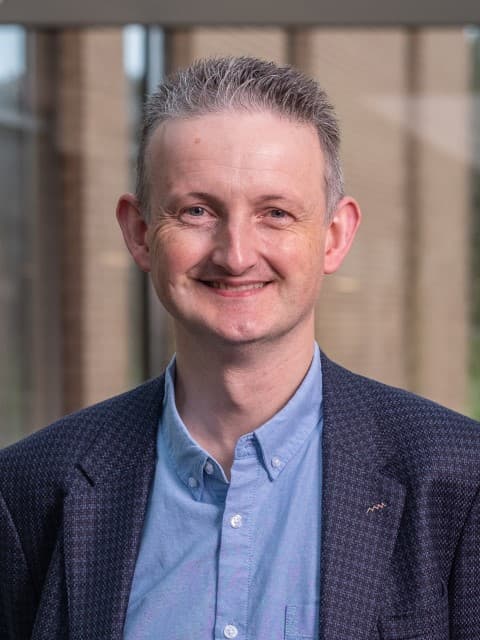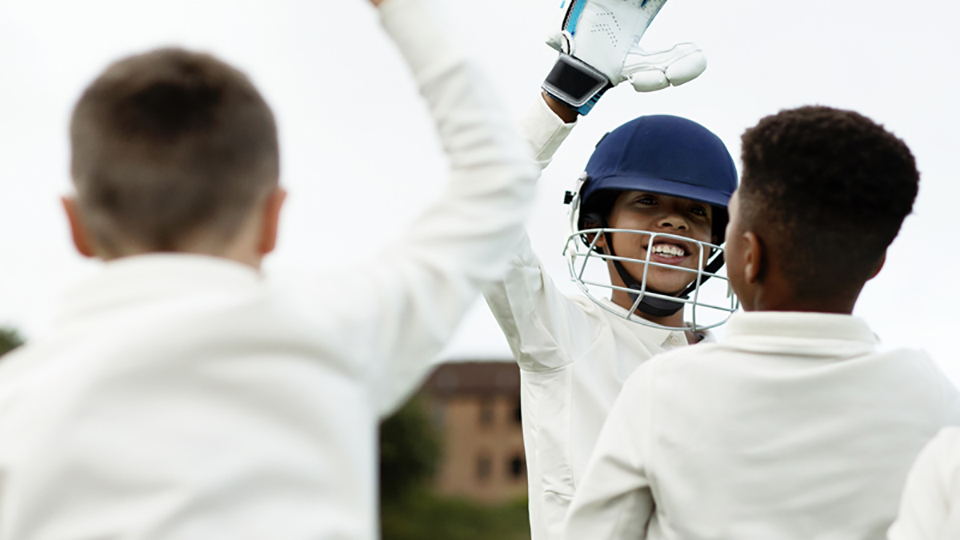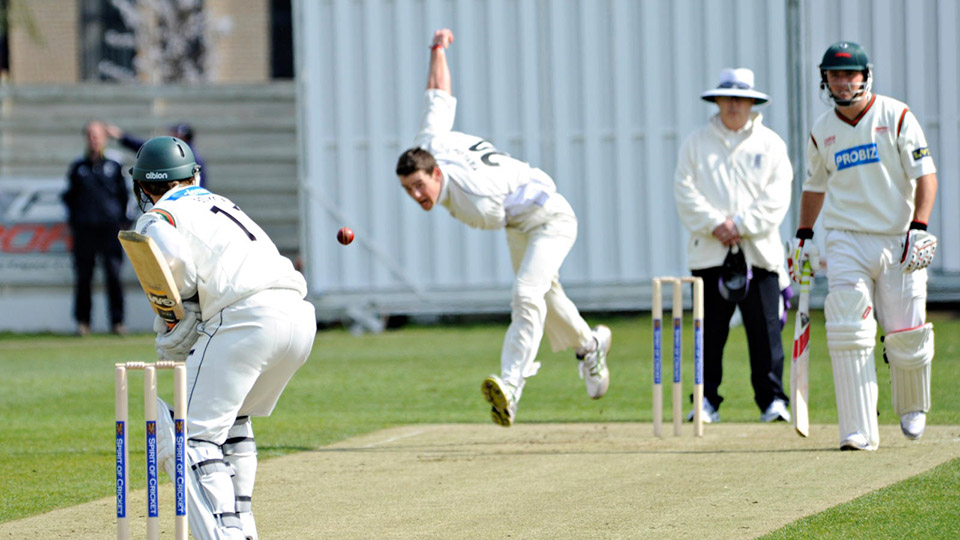Mark did his degree (Mathematics and Sports Science, 1993) and PhD (subject-specific computer simulation of dynamic jumping, 1998) at Loughborough. He was appointed as Lecturer in Sports Biomechanics in 1999, progressed to Senior Lecturer (2006), Reader (2012) and Professor of Sports Biomechanics in 2019. Mark is currently the Lead for the Sport Performance Research Theme in the School of Sport, Exercise and Health Sciences. He has been the Warden of Royce Hall since 1999 and is responsible for the welfare of 375 students.
In cricket, Mark has strong links with the England and Wales Cricket Board and the International Cricket Council. Mark is accredited as a Human Movement Specialist for both the ECB and ICC and Loughborough is accredited as an ICC testing centre for suspected illegal bowling actions. Furthermore, in racket sports Mark has strong links with Badminton World Federation, the Tennis Foundation and the Lawn Tennis Association.
Sport-wise, Mark is currently Senior County Captain for Leicestershire Badminton having represented Leicestershire 1st team over 100 times. At Masters level, Mark has won medals in Badminton at English National, All England, European and World Levels.
Over the last 20 years, Mark has developed the field of subject-specific torque-driven computer simulation modelling including advances in determining subject-specific torque parameters and visco-elastic parameters, incorporating wobbling masses, optimising human movement within a perturbation environment, incorporating biarticular effects, and modelling the transmission of force through the body using visco-elastic elements within joints. Mark’s contributions to this field are world leading and were first recognised when he received the Young Investigators Award at the European College of Sport Science in 1997 and subsequently five of his PhD students have won awards for their work on simulation modelling (including the prestigious New Investigators award at the International Society of Biomechanics in Sport (twice) and the Andrzej Komor New Investigators award at the International Engineering of Sport Conference). Mark has currently published 30 academic journal papers on computer simulation, delivered six keynote lectures and 16 invited presentations.
Since 2004, Mark has developed and sustained strong links with the ECB with collaborative PhD research projects on: lower back injuries in fast bowling, fast bowling performance, computer modelling of fast bowling, power hitting in batting, spin bowling, optimum pitch lengths for junior cricketers, and vertebral adaptation / stress fracture in fast bowling. The findings of these projects have had a direct influence on the coaching of cricket and were recognised in REF2014 through a highly rated impact case study. The success of the research in fast bowling justified the ECB funding a post-doc position for four years plus two new PhD studies linked to the National Centre for Sport and Exercise Medicine. In addition, the collaboration with the ECB and Mark’s research into illegal bowling actions enabled Mark to establish an International Cricket Council accredited Centre at Loughborough in 2014.
In the last six years Mark’s research scope has extended further to include research on racket sports focusing on badminton, tennis and wheelchair tennis in collaboration with the Badminton World Federation, Marque Makers, Tennis Foundation / Peter Harrison Centre and The Lawn Tennis Association. These collaborations have secured over £200k of external funds to support research studies.
To date Mark has received over £1.5 million in externally funded grants for research and approximately £100k in enterprise funding. Mark has 67 journal publications including 16 in Journal of Biomechanics and 14 in Journal of Sports Sciences.
Selected Research Projects and Sources of Funding
- Computer simulation modelling of fast bowling to minimise lumbar stress fractures in cricket, EPSRC DTP and ECB £69,000. 2019-2023
- Modelling of prosthetics for Olympic athletes, English Institute of Sport, £50,000, 2019-2020.
- Developing the world’s fastest badminton racket, Marque Makers, £90,000, 2018-2021.
- Optimum performance in the badminton smash. Badminton World Federation. £18,000. 2016-2019.
- Technical excellence project – fast bowling in cricket. ECB, £95,000. 2015-2019.
- Investigating appropriate pitch length for junior age group cricket. ECB, £30,000. 2014-2017.
- Maximising spin rate for finger spinners and wrist spinners in cricket. ECB, £23,000. 2010-2015.
- Technique and performance in batting against short pitch bowling. ECB, £20,000. 2011-2015.
- Optimising Fast Bowling Performance in Cricket. ECB, £100,000. 2010-2015.
- Bowling Action Research - ICC Project. ICC, £4,500. 2009-2010.
- Fast bowling: performance and injuries. ECB, £80,000. 2006-2010.Investigating feel fatigue and injury in tennis. EPSRC (IMRC) and Head sport, £222,000. 2002-2007.
- 2019-, Co-Founder and Director for Performance, PQ(lboro).
- 2019, Chairperson, 6th World Congress of Science and Medicine in Cricket.
- 2017-, BWF Injury Prevention Working Group, Badminton World Federation.
- 2017-, Bowling Legality Group, International Cricket Council.
- 2010-2017, Chair of the International Society of Biomechanics Technical Group on Computer Simulation.
- 2005-2010, Executive Board of the ISB Technical Group on Computer Simulation.
- 2013, Co-Chairperson for the XIV International Symposium on Computer Simulation in Biomechanics.
- 2009, Chairperson for the XI International Symposium on Computer Simulation in Biomechanics.
- 2014, Human Movement Specialist, U19 Cricket World Cup, Dubai.
- 2012, Visiting Professor, University of Vienna.
- 2007-, Human Movement Specialist, ICC.
- 2005-, Human Movement Specialist, ECB.
Selected Invited Conference Keynote and Speaker Presentations
Keynote lectures
- 2020, International Conference on Advances in Mechanical Engineering, Nagpur, India.
- 2017, World Badminton Coaches Conference, Glasgow, UK.
- 2015, 10th Asian Conference of Sport Science, Seoul, Korea.
- 2015, ECB Coaches association National Conference, Warwick, UK.
- 2012, Sports Video Analysis and Computation, Swansea.
- 2011, International Society of Biomechanics in Sport, Portugal.
- 2009, British Science Festival.
- 2009, 11th ICHPER Europe Regional Congress, Turkey.
- 2008, Pre-Olympic Congress, Nanjing, China.
- 2008, LTA Sports Science and Sports Medicine Conference, London.
Invited lectures
- 2018 Early Stage Innovation and Industry-Academia Collaboration, Sports Tech Transfer and R&D Summit.
- 2018 Maths and Movement, French Society of Applied Maths, Paris, France.
- 2016 4th World Javelin Conference, Kuortane, Finland.
- 2015, 6th International Sports Medicine and Sports Science Conference, Putrajaya, Malaysia.
- 2015, England Performance Programme, National Cricket Performance Centre, ECB, Loughborough.
- 2015, Sports Science Summit, O2 Arena, London.
- 2014, High Performance Programme, ICC, Dunkeld, Scotland.
- 2014, Movement profiling, National Cricket Performance Centre, ECB, Loughborough.
- 2012, ASME: Bioengineering conference, Puerto Rico.
- 2010, IUTAM conference, Belgium
- 2009, 10th US National Congress on Computational Mechanics, USA
- 2008, 8th World Congress on Computational Mechanics WCCM8
- 2007, 1st IMA Conference on Mathematics in Sports, UK
- 2006, 5th World Congress of Biomechanics, Germany
Featured publications
- Alway. P., Peirce, N., King, M.A., Jardine, R., Brooke-Wavell, K., Peirce, N. 2019. Lumbar bone mineral asymmetry in elite cricket fast bowlers. Bone, 127,537-543.
- King, M.A., Kong, P.W., Yeadon, M.R. 2019. Maximising forward somersault rotation in springboard diving. Journal of Biomechanics, 85, 157-163.
- Harwood, M.J., Yeadon, M.R., King, M.A. 2018. Reducing the pitch length: effects on junior cricket. International Journal of Sports Science & Coaching, 13, 1031-1039.
- Sayyah, M. Hiley, M.J., King, M.A., Yeadon, M.R. 2018. Functional variability in the flight phase of one metre springboard forward dives. Human Movement Science, 59, 234-243.
- King, M.A., Yeadon, M.R. 2015. Advances in the development of whole body computer simulation modelling of sports technique. Movement and Sports Sciences - Science et Motricite, 43, 55-67.
- McErlain-Naylor, S.A., King, M.A., Pain, M.T.G. 2014. Determinants of countermovement jump performance: a kinetic and kinematic analysis. Journal of Sports Sciences, 32, 1805-1812.
- King, M.A., Yeadon, M.R. 2012. Quantifying elbow extension and elbow hyperextension in cricket bowling: A case study of Jenny Gunn, Journal of Sports Sciences, 30, 937–947.
- King, M.A., Kentel, B.B., Mitchell, S.R. 2012. The effects of ball impact location and grip tightness on the arm, racquet and ball for one-handed tennis backhand groundstrokes. Journal of Biomechanics, 45, 1048-1052.
- King, M.A., Lewis, M.G.C., Yeadon, M.R. 2012. Is it necessary to include biarticular effects within joint torque representations of knee flexion and knee extension? International Journal for Multiscale Computational Engineering, 10, 117–130.
- King, M.A., Kong, P.W., and Yeadon, M.R. 2009. Determining effective subject-specific strength levels for forward dives using computer simulations of recorded performances. Journal of Biomechanics. 42, 2672-2677.
- King, M.A., Wilson, C. and Yeadon, M.R. 2006. Evaluation of a torque-driven model of jumping for height. Journal of Applied Biomechanics. 22, 264-274.
- King, M.A. and Yeadon, M.R. 2005. Factors influencing performance in the Hecht vault and implications for modelling. Journal of Biomechanics, 38, 145-151.
- King, M.A. and Yeadon, M.R. 2004. Maximising somersault rotation in tumbling. Journal of Biomechanics, 37, 471-477.
- King, M.A. and Yeadon, M.R. 2003. Coping with perturbations to a layout somersault in tumbling. Journal of Biomechanics, 36, 921-927.
- King, M.A. and Yeadon, M.R. 2002. Determining subject-specific torque parameters for use in a torque-driven simulation model of dynamic jumping. Journal of Applied Biomechanics, 18, 207-217.


